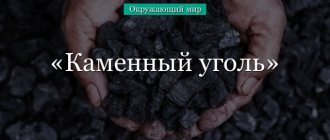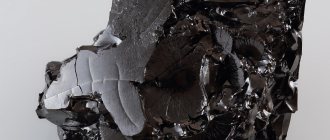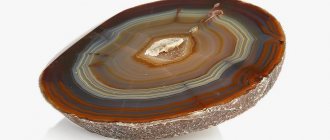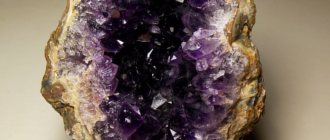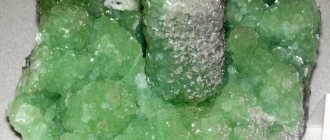Post updated: May 26, 2020
Gold is a noble metal that has a rich and bright yellow color. Such a precious mineral as gold is very valuable, both in the economy and in the industrial sphere. This precious metal is included in the table of chemical elements created by the famous scientist Mendeleev. In the table, this material is in 79th place. Few people know, but if you translate the word “gold” into all the languages of the world, then every time it will be translated as “yellow”. The translation from Latin has a connection with Aurora - the goddess of the dawn.
Gold mining began hundreds of years ago. Mentions of this metal are even present in the Bible, where it is described as a precious gift. It was even used as a method of execution. In ancient Rome, those on death row had red-hot gold poured down their throats. The first gold coin appeared long before our era.
- Varieties and characteristics
- Places of origin and production
- Areas of application
History of gold mining in Russia
The history of Russian gold mining goes back about three centuries.
Before this, for many centuries, gold was purchased abroad, spending their national wealth on it. Although back in the 5th century BC, the “Father of History” Herodotus claimed that in the Urals (at that time they were called the Riphean Mountains) there were significant reserves of this noble metal. And indeed, while uncovering ancient Scythian burials, secret diggers - “hillsters” discovered many unique gold items from a vanished civilization.
Since the 40s of the 18th century, the situation has changed radically. Gold has already been discovered in Altai, in Karelia at the Voitsky copper mine, and in the Arkhangelsk province they found a gold mine, from which 65 kg of the precious metal was subsequently extracted over half a century.
But still, the first industrial deposit was the Shartashsky mine (later on - Initial), discovered in 1745 by Erofei Markov. By the middle of the century, the Berezovsky mine, which arose on its basis and included 50 mines, produced 16 kg of gold. By the 60s, production amounted to 32.6 kg, by the 70s – over 65 kg. And in 1806, 5.8 tons of gold were produced, which at that time accounted for 85% of all production in the state.
Gold mining received further development much later than Catherine II’s decree of 1782, which declared a state monopoly on the development of metals. Although during the second half of the 18th century, yellow metal was found on all slopes of the Ural Mountains, except the north. The discovery of large nuggets on the Chusovaya River, the gold reserves of which continue to be developed to this day, was significant.
The decree of Alexander I, which opened up freedom in the extraction of precious metals, made it possible to begin the development of placer deposits using the technologies of Lev Brusnitsin. His discovery of the Ufaleysky primary deposits and successful research on the Berezovka River led to a gold rush in Russia. 200 new alluvial deposits, the first place in terms of gold production in the world, and constant improvement of technology have led to a sharp increase in mineral production.
The noble metal was rediscovered in Altai, Western Siberia, in the Vyatka province. In the future, fishermen and ore miners increasingly rush to the east. The Yenisei region, Transbaikalia, the Amur region, and Primorye are becoming new gold mining areas. The Lena, Kolyma and Chukotka river basins are added to them.
During the time of the Russian Empire, 2,644 tons of gold were extracted from the bowels of the earth. The same figure during the existence of the USSR was 10,985 tons. From 1991 to 215, gold production amounted to 4404.1 tons.
Gold plates
Places of origin and production
This material is the oldest among all others. The mining of this precious metal began almost at the same period when the first deposits of copper began to be found, back in Neolithic times. But even despite the fact that gold nuggets began to be mined a very long time ago, today they are found quite rarely. If we turn to historical and statistical data, then over the entire existence of mankind, only 165 thousand tons of this mineral were mined.
If you make one solid cube from all this amount of precious substance, then its side will be about twenty meters. If we make a comparison, the same amount of iron can be extracted in less than an hour.
Today, the largest number of nuggets can be found in the territory of the Republic of South Africa. Also, a large amount of gold reserves are located in China and America. Russia ranks 6th in this rating list. An important reason for this was that America received Alaska, which previously belonged to the Russian Federation. Based on current exchange rates, Alaska was valued at 100 million US dollars. Gold is a precious mineral that is abundant in Alaska. You can learn about this from numerous photo and video reports.
Chukotka and the Amur region are the most significant regions. Where most of the reserves are located. Today, a wide variety of mining methods are used. The main criterion for choosing one method or another is the type of deposits. In order to extract nuggets, a thorough washing method is used. There are places where matter is dispersed. In order to detect and collect it, they use amalgamation.
The largest gold mining sites in the world.
Ores containing this noble material may contain other substances and impurities. In order to extract the purest possible material, it is necessary to carry out a regeneration process or apply cyanidation. There are special factories and production facilities that professionally engage in refining. They use technologies that have a high level of complexity and consist of many stages.
Extraction methods
Washing of placers
The oldest method of gold mining, based on the high density of the mineral. Using a tray, miners wash gold-bearing sand by hand, sifting out lighter rocks. This produces a heavy fraction called concentrate, which requires further processing. Sometimes it contains other valuable metals and stones.
More modern technologies for washing placers or bedrock use dredges and industrial washing plants, which can significantly increase the productivity of the process.
Extraction of gold from rocks through amalgamation, chlorination or cyanidation
Amalgamation is a method of extracting gold by forming compounds of highly concentrated mineral rocks with mercury. After this, the amalgam is extracted from the sludge and separated into gold and mercury, which is then reused.
Cyanidation uses the dissolution of gold in cyanide (solutions of hydrocyanic acid or its salts). The precious mineral is then deposited using ion exchange resins or zinc dust. The same process used to deposit gold on sorption columns and return the recovered cyanide to reuse is called heap leaching.
Chlorination of gold is a method known to the inhabitants of pre-Columbian America, based on the dissolution of the mineral in chlorine with its further conversion into a gas that is precipitated and dissolved by water. This allows you to concentrate the metal in the right place. There are also options for pure gas technology. By heating a mixture of gold ore with table salt and clay, the Indians obtained a huge amount of gold for those times.
Industrial
Extraction of gold-containing ores from the earth's crust to the surface, from various depths, is carried out by open or closed methods. Preliminary geological exploration determines the presence of gold-bearing layers and the feasibility of their development.
Shakhtnaya
The mining technology using the mine method is quite labor-intensive. In addition to the construction of the underground structures themselves, the development of frozen soils and the removal of melt water is required. With the introduction of longwall mining techniques and the use of modern technical devices (belt conveyors, hydraulic units, steam needles), the process has become significantly more efficient. Labor productivity has increased and rock yield has increased.
The undoubted advantage of this method is the possibility of developing gold deposits with a depth of 10 m. Sometimes permafrost is a favorable factor for mining ores in this way.
Career
The process involved in removing the top layer of waste rock and mining the gold-bearing layer of soil. In case of high hardness of materials, drilling and blasting technologies can be used. The ore mined by excavators is loaded onto vehicles, which is then sent to processing plants. Where its further development takes place.
Highly specialized techniques
Gravitational differentiation method
One of the oldest, but still relevant, methods of extracting gold from rocks, used in most modern enterprises. Its essence lies in the preliminary grinding of ore with heavy cast iron balls inside rotating mill drums. Then, in centrifuges, the fractions are separated into a light part and a heavy part (richer in gold). After which both are subjected to processing processes corresponding to their properties.
Using a metal detector
Constant technological progress makes adjustments to the ancient process of searching for minerals. One of these advances, which greatly facilitates the search for metals, is metal detectors. Moreover, modern designs of these devices allow specialization for specific chemical elements. Despite all their shortcomings, these devices make it possible to detect large fractions of yellow metal, as well as its nuggets. Therefore, we can safely conclude that metal detectors have a great future in mineral exploration. Including gold.
Using the flutter
A technology used primarily to capture the smallest gold particles. Well crushed rock is poured with oil and mixed thoroughly, adding water. As a result, light “fatty” particles end up on the surface. It is not difficult to remove them from there and clean them, say, using subsequent cyanidation. In industrial production, to increase the productivity of the process, the mixture is purged with air.
Why is gold difficult to mine?
Illustration of gold mining by washing gold-bearing sand
Gold is a metal that, unfortunately, is almost impossible to extract, even if there is a considerable amount of it in the bowels of the earth. The difficulty of finding it is that it is scattered throughout the mine or the ocean floor. But at the same time it became the first metal that man found. Almost all gold is found in the metallic core of the earth, where it is extremely difficult to obtain. But nothing stands still, technology is improving, and over the past few years people have begun to mine many times more of this metal. It has been found in small rivers and even streams.
Production in the cold season
The specificity of developing gold deposits during low temperatures has a number of significant advantages:
- Solving a number of transport problems not burdened by spring-autumn thaw and damp summer soil.
- The absence of significant groundwater flows and a decrease in the level of surfaces of reservoirs.
- Favorable opportunity to remove forest shrub cover and remove hard soil.
- Improving the optical characteristics of the desired mineral.
In general, it can be noted that gold mining at one time or another of the year is most appropriate, taking into account the specific circumstances of organizing the process at the location.
Production processes in the production of precious metals
The heap gold leaching method involves a number of production processes, the result of which is the yield of a pure precious product:
- after delivering the gold ore to the processing plant, it is placed in mills, where it is crushed to a certain fraction;
- after this, the material is passed through sieves and goes through a pelletizing stage, which prevents the factions from sticking together into large compounds;
- then the resulting mass is sent for leaching with sodium cyanide and formed into an ore pile;
- the next step is the separation of waste ore from metal cyanide compounds by sorption;
- the extracted gold-containing compounds are sent for galvanization, where preliminary purification occurs.
The completion of the process is the melting of the resulting sediment until the alloy is released, which is subsequently leached from ore residues.
Applications of gold
Jewelry industry
Due to its unique aesthetic properties, gold has always been used as a material for the manufacture of exquisite jewelry. Over the centuries, the situation has hardly changed. A significant part of this noble metal ends up in the hands of jewelers who create a variety of jewelry.
However, pure metal, due to its softness, is unsuitable for these purposes. Alloys of gold with copper and silver have proven themselves much better; with additives from non-ferrous metals. This mixture of chemical elements makes it possible to obtain raw materials of the required strength and the desired color shade.
It has become common practice to stamp finished jewelry to indicate its fineness—the content of gold (or other precious metal) in the alloy being hallmarked.
Gold
Investment
Due to a number of historical reasons and physical characteristics: durability, resistance to corrosion, gold has become the most important element of the financial market and the largest source of investment. It can be stored almost indefinitely, and the liquidity of this metal remains constant for centuries. This turns this mineral into one of the most convenient options for investments and long-term savings.
State gold and foreign exchange reserves
One of the areas of use of the described precious mineral is the formation of gold and foreign exchange reserves, which represent highly liquid assets, which include gold in the form of coins. It should be noted that these funds are under the control of government authorities.
Coinage
The use of gold as a national (sometimes international) currency has an ancient history. Moreover, in the 19th and early 20th centuries, all world currencies were tied to a single gold standard. And today, many countries around the world mint investment and commemorative coins based on very high-grade gold. Although paper banknotes have long become the main means of circulation.
Technology and industry
The technical use of the mineral is based on the use of a number of its special properties: softness, malleability, ductility; high electrical conductivity, resistance to chemical influences, reflectivity. The areas of application of this noble metal are:
- Transport.
- Chemical industry.
- Energy.
- Instrumentation and electronics.
- Telecommunications.
- Nanotechnology.
- Nuclear physics.
- Production of modern weapons.
- Cosmonautics.
Food production
Cooking boasts an exotic use for gold. It is here that the exquisitely refined tastes of gourmets are activated under the influence of gold leaf decorations that are part of the manufactured products. This mineral is also used as an original food additive for drinks and food. Which becomes a kind of means of attracting very wealthy clients to the most expensive restaurants on the planet.
Dentistry
This branch of medicine uses gold as a material for dental prosthetics. This becomes possible due to the chemical inertness of the noble mineral and its plastic properties.
Pharmacology
In pharmacology, gold is used to treat autoimmune diseases and cancer.
Physical and chemical properties of metal
This is one of the few noble metals that can be found in nature in its pure form. Pure gold is very soft, only 2.5-3 on the Mohs hardness scale. This is a plus for easy metal processing: one gram of gold can be rolled into a thin sheet with a thickness of only 230 atoms and an area of one meter. But the softness of gold is a disadvantage for the strength of products made from it, so gold is most often alloyed with other metals.
Gold is a good conductor of heat and electricity and is resistant to oxidation and corrosion. The noble metal has a very high boiling and melting point.
Advertising - Continued below
The temperature required to melt gold is 1065°C and the boiling point is 2856°C.
Deposits in Russia and the world
The list of the world's largest gold deposits is headed by:
- Sukhoi Log. Irkutsk region, Russia The estimated reserves of this deposit are 2700 tons!
- Las Cristinas. Suburb of Las Claritas, Venezuela. 480 tons of reserves.
- Xilin Mine. Shandong Province, eastern China. 382 tons.
- Vasilkovskoe. A suburb of Kokshetau, northern Kazakhstan. 360 tons.
- Bakyrchik. Eastern Kazakhstan. 200 tons.
- Witwatersrand. SOUTH AFRICA.
- Muruntau. Uzbekistan. The largest open-pit gold mine. Residual reserves amount to 1,750 tons.
- Grasberg. Indonesia.
- Goldstrike. State of Nevada, USA.
- Cortes. State of Nevada, USA.
- Pueblo. Viejo. Dominican Republic. 183 tons of deposits.
- Yanacocha. Peru.
- Carlin. USA.
- Peñasquinto. State of Zacatecas, Mexico.
- Veladero. Chile and Argentina.
- Lihir. Papua New Guinea.
- Boddington. Western Australia.
- Berezovskoye field. Russia.
The largest gold mining companies in Russia
The results of 2022 ranked the leading Russian gold miners in the following order:
- 1st place – PJSC Polyus.
- 2nd place – Polymetal Group of Companies.
- 3rd place – KinrossGold.
- 4th place – Petropavlovsk Group of Companies.
- 5th place – Nordgold Group of Companies.
- 6th place – JSC Yuzhuralzoloto GC.
- 7th place – HighlandGold.
- 8th place – PJSC “Vysochaishy” (GV Gold).
- 9th place – JSC “Pavlik”.
- 10th place – PJSC Seligdar.
- 11th place – PJSC Susumanzoloto.
- 12th place – GRK Bystrinskoye (Norilsk Nickel).
- 13th place – JSC “Gold of Kamchatka”.
- 14th place – JSC “Priisk Solovyovsky”.
- 15th place – Sibzoloto Holding.
- 16th place – JSC GRK “Zapadnaya”.
- 17th place – Arbat Concern.
- 18th place – “Artel of Prospectors Vitim”.
- 19th place – JSC Okhotsk Mining and Gas Concentrating Company.
What have we learned?
Russian gold is mined in Siberia from dense rocks and placers. Currently, waste dumps from old mines and placers are being processed. You can briefly talk about gold and how it is mined in a report for grade 4.
Previous
The world around usProperties of air (grade 3) briefly about the composition and properties of air for a report or message on the world around us
Next
The world around us Summer natural phenomena - examples for schoolchildren briefly in animate and inanimate nature (2nd grade, the world around us)
Gold market
77 countries of the world are showing significant business activity in the global gold market. The sales leaders in the 1st quarter of 2020 were: Switzerland, Canada, USA, Thailand and Australia. However, following the results of the first 8 months of the year, Uzbekistan came out on top as exporters, selling precious metal worth $5.8 billion.
The leading importers recently are: Türkiye, India and China. However, this niche of world trade is characterized by extreme instability and is strongly influenced by the political and economic conditions of the current moment.
Author: Yuri Florinskikh All articles by this author
Latest articles by the author: The largest producers of milk and dairy products in the world Diamonds: properties, mining methods and applications
The process of gold formation in nature
Gold deposits
Precious metals are found everywhere in nature, including the world's oceans and even plants, but there are no sufficiently effective methods for extracting them. Therefore, gold mining is carried out in deposits that are of two types.
Primary, called radical - their formation is associated with magmatic activity, when many molten components erupt to the surface of the earth, including gold-containing salt solutions, solidifying into veins.
Secondary, called alluvial - they are formed as a result of the release of precious metal from gold ore under the influence of natural processes (river flows, the appearance of ravines, rock falls) or climatic disasters (floods, mudflows, heavy rains).
When water erodes gold-bearing veins, it can carry particles of the yellow metal over considerable distances. Especially large pieces are called nuggets. Their weight varies from 5 grams to several kilograms.

